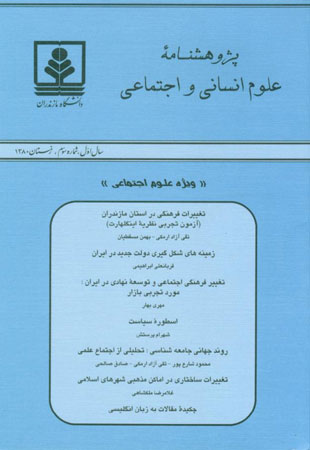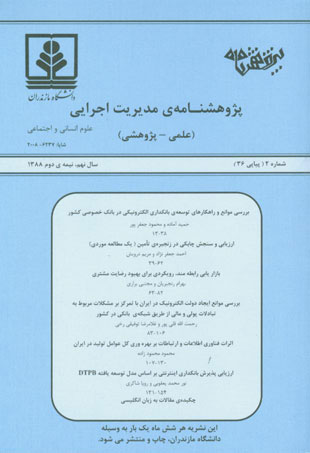فهرست مطالب

پژوهشنامه علوم انسانی و اجتماعی
پیاپی 3 (زمستان 1380)
- ویژه علوم اجتماعی
- 190 صفحه، بهای روی جلد: 6,000ريال
- تاریخ انتشار: 1381/03/13
- تعداد عناوین: 7
-
-
صفحه 13دوران گذار از جامعه سنتی به مدرن از جهات گوناگون مورد توجه جامعه شناسان و صاحبنظران علوم اجتماعی بوده است و بسیاری از نظریه پردازان به نوعی مبنای نظریه اجتماعی خود را به شرایط اجتماعی ویژه دوران گذار ارتباط داده اند. از وارد شدن به جزییات این مباحث خودداری کرده، سعی کرده ایم از منظر اینگلهارتی به آن توجه کنیم.
کلیدواژگان: ارزشهای اجتماعی، استان مازندران، Englhard، خانواده، توسعه اقتصادی -
صفحه 41مقاله حاضر حاصل یک پژوهش کتابخانه ای در خصوص دولت جدید در ایران است. دولت جدید یک پدیده و واقعیت اجتماعی-سیاسی است که از قرن شانزدهم به بعد در جهان ظاهر شد. ظهور و شکل گیری این پدیده، در جامعه تصادفی نبوده است بلکه به دنبال فراهم شدن شرایط و زمینه های اقتصادی، اجتماعی و فرهنگی خاص پدید آمده است.
کلیدواژگان: دولت جدید، جامعه شناسی سیاسی، سیاست، نوسازی، تاریخ معاصر ایران، نظریه دولت -
صفحه 77در این مقاله به بیان نحوه قرار گرفتن جامعه ایرانی (شهر تهران) در جریان جهانی شدن از طریق تفکیک نهادی در طول دو سده اخیر توجه شده است. این مساله به این دلیل دارای اهمیت است که جریان جهانی شدن جریان فراگیر است و تمام فرهنگها را اعم از فرهنگ سنتی یا مدرن تحت تاثیر قرار داده است.
کلیدواژگان: بازار، جهانی شدن، تفکیک نهادی، دین، اقتصاد، نظام آموزشی -
صفحه 103مقاله «اسطوره سیاست» با عنوان فرعی «ساخت اجتماعی واقعیت سیاسی» به یک آموزه جامعه شناختی اشاره دارد. این آموزه لایه سیاسی ذهن ایرانی را به عنوان پوسته واقعیت اجتماعی در نظر می گیرد؛ از این رو، واقعیت اجتماعی چندین لایه دارد، و هسته آن فروپوشیده است. نوشتار حاضر می کوشد آموزه یاد شده را با نگاهی تبارشناسانه به چالش درکشد.
کلیدواژگان: ساخت اجتماعی، واقعیت اجتماعی، واقعیت سیاسی، ذهن سیاسی، وجوه عینی و ذهنی، تبارشناسی، استبداد ایرانی، دمکراسی -
صفحه 131اجتماع علمی را می توان جمع دانشمندان و محققانی دانست که مطابق قواعد و هنجارهای رسمی و غیررسمی در تعامل با یکدیگر بوده، با اجتماعات علمی دیگر در ارتباط فعال است. اجتماع علمی دارای اجزا و عناصر متنوعی می باشد که از این میان به انجمنهای علمی و ارتباطات علمی اشاره کرد.
کلیدواژگان: انجمن بین المللی جامعه شناسی، اجتماع علمی، روند جهانی جامعه شناسی، ارتباطات علمی، کنگره جهانی جامعه شناسی، انجمن علمی -
صفحه 161بین اسلام و زندگی شهری، رابطه خاصی وجود دارد و ترویج اسلام با توسعه و ترویج زندگی شهری متجلی شده است. تاریخ اسلام، با پی ریزی و ایجاد انواع مختلف شهر آغاز شده است. اماکن مذهبی در شهرهای اسلامی از عناصر بنیادی اسکلت شهری و فرهنگ اسلامی به شمار می آیند.
کلیدواژگان: اماکن مذهبی، شهرهای اسلامی، جغرافیای فرهنگی -
صفحه 185
-
Page 13Sociologists have focused their attention on transition from traditional society to modern society from different perspectives. Many theoreticians have somehow related their social theory to the social conditions which are characteristic of the transition. The details of the discussion will be avoided and the issue will be looked at from Inglehart’s perspective. In social-political literature, Iran is a society which is in the transitional stage from traditional society to modern society, as the major attempts which have been made in this connection at different periods of time have often involved this transition. In this process, the first thing which occurs concerns population. This research attempts to show whether within the area of population any change has occurred in values (familial, sexual, political, economic, religious, social and moral values). To demonstrate the changes in the area of population two models of age group and life experience have been used.The statistics have been obtained through the empirical research conducted in Mazandaran Province. The research was done with a sample of 384 subjects and interviews, and the data were analyzed in questionnaires.The analyses which were based on Inglehart’s theory indicates that, in general, no change can be observed in different age groups considering their cultural backgrounds, and among the variables, education was the only one most influential in the change of values.
-
Page 41This article is the result of a library research on “new state” in Iran. New state is a social - political phenomenon and a reality which appeared in the world after the sixteenth century. This is not an accidental phenomenon but consequent upon certain economic, social and cultural conditions, and it did not occur at the same time in different societies. The article examines the factors influencingthe formation of new state in contemporary Iran drawing upon theories such as Marx’s theory of economic determinism Weber’s burearu craticnature, Durkheim’s social division of labour and Parsons’diffrentiation and adaptation.
-
Page 77This article focuses on the position of Iranian society (the city of Tehran) in the process of globalization through institutional differentiation in the last two centuries. Why this issue is of significance is because globalization has affected all cultures including traditional and modern cultures. What this research concentrates on is what kinds of influence globalization has had on Tehrani community (Bazar) and how. Assuming that there has been some influence, we have emphasized the effect of globalization in the main part of Tehrani community, i.e., Bazar, which is the center of economic, political, social and cultural activities. In addition, considering that mass media is the main factor in this process, we have paid attention to the relationship between globalization and social institutions. The observation of Bazar suggests that modern media such as television have facilitated the social-cultural change of institutional differentiation as the element of globalization in interaction with traditional media in Tehran.
-
Page 103This article draws upon a sociological doctrine. The doctrine regards the political level of Iranian mind as an appearance of the social fact. The social fact has several levels, and its essence is hidden. The article challenges the above-mentioned doctrine with a genealogical approach. The first part deals theoretically with the constructed fact on the one hand, the fact being constructed on the other, and the dual face of the social fact with the two corresponding discourses in sociology. The second part explains the objective aspect of Iranian despotism in the light of Marx and Witfogel’s approaches. The next part regards the political mind as a subjective aspect of this fact. The final part formulates a problem: The paradoxical fact of recent political phenomenon. The objective aspect of this fact has prepared conditions for democracy in Iran, while it’s subjective aspect tends towards despotism.
-
Page 131A scientific community can be defined as a group of scientists and researchers who according to certain rules and formal and informal norms interact with each other and actively communicate with other scientific communities. A scientific community enjoys diverse elements such as scientific associations and scientific communications. A scientific association is often regarded as an indicator and a manifestation of the trend of a scientific knowledge.By examining the recent Congress of the International Sociological Association, the present article attempts to identify the global trend of sociology. It is assumed that since this meeting was the largest congregation of sociologists from all over the world, the analyses of the papers presented in the congress can, to a large extent, indicate the trend of sociology at global level.In order to achieve this goal, the papers presented in the Research Committees of the World Congress of Sociology (held in Australia, in July 2002) were analyzed according to certain criteria: distribution of the papers by countries, the language used in the congress, single-authorship and co-authorship, the relationship between socio-economic variables and scientific output, and the specialized areas focused on at the congress. In the final part of the article, the sociological priorities of some of the countries have been identified.
-
Page 161There is a specific relationship between Islam and urban life. Dissemination of Islam is represented by the development and progress of urban life. Islamic history began with the foundation and establishment of different kinds of cities. Religious places are regarded as fundamental elements of Islamic cities and Islamic culture. The present article studies the transitional phases from a classical model of Islamic city to an entirely different model. The classical model represents a city in which there is a central place for political and religious congregations (masjed-e-jame) and in which the Islamic government supports justice and denounces all forms of cultural and social discrimination. The latter is an expression of a city which enjoys different religious places and a palace which is the central part of the city government and in which the relations between political and religious figures are cut off.


